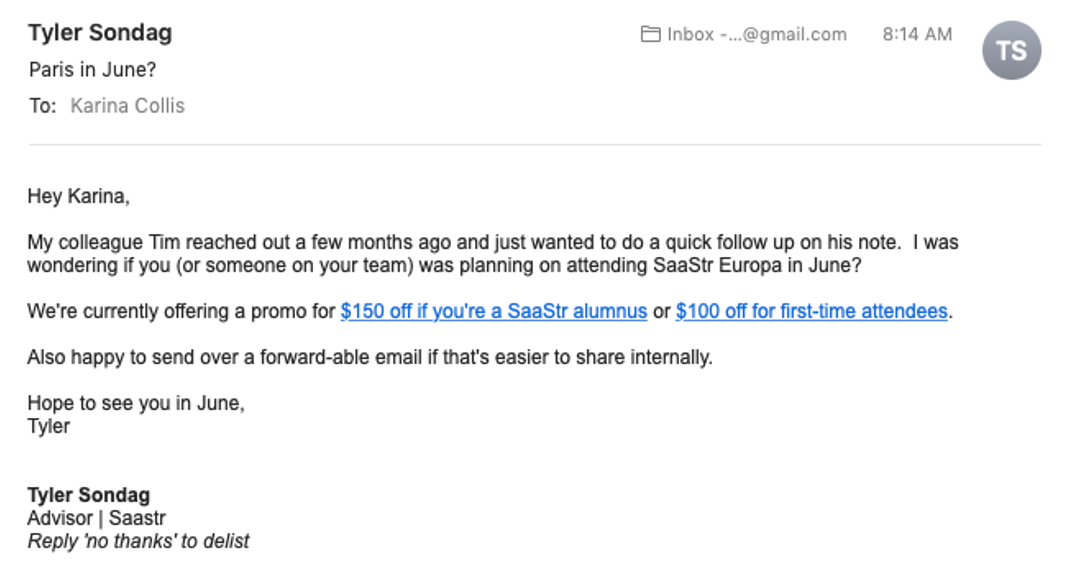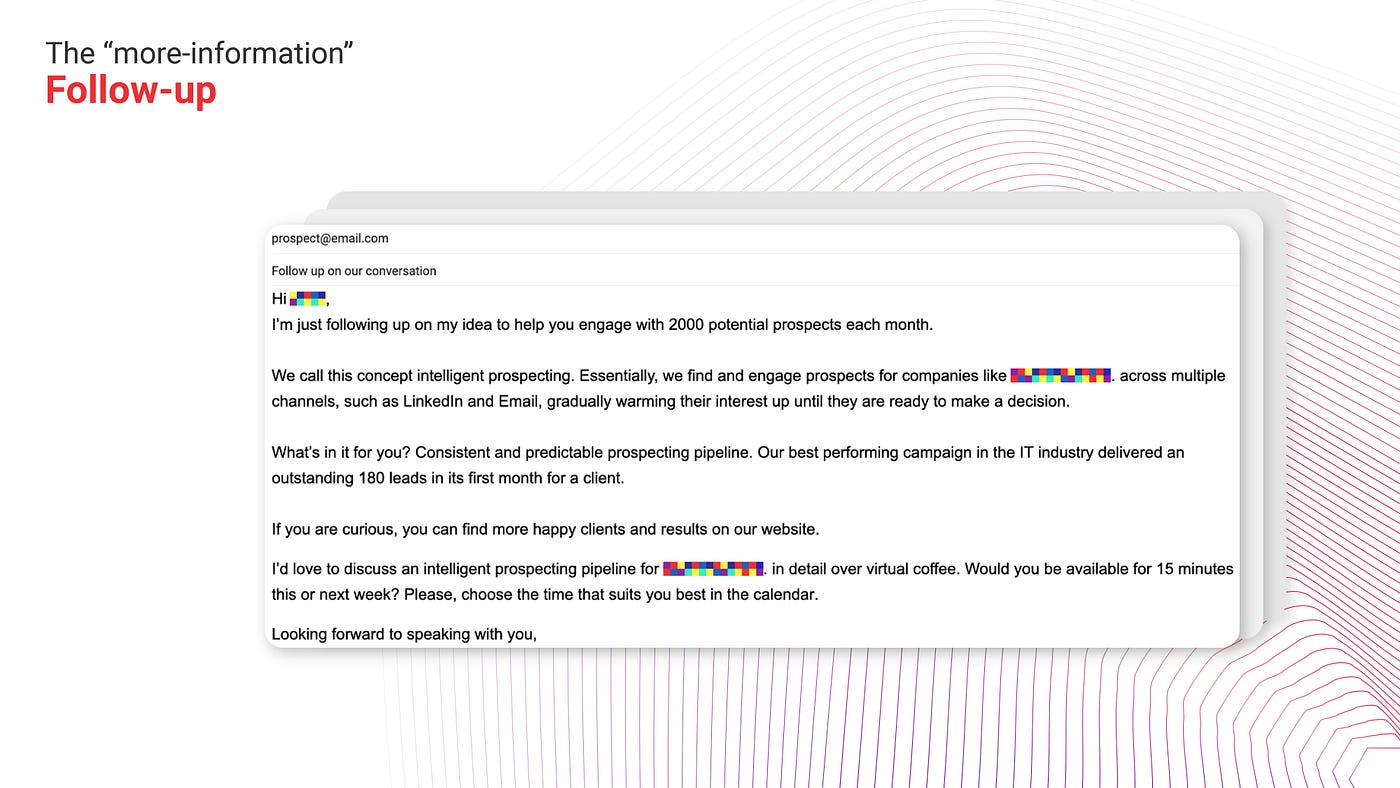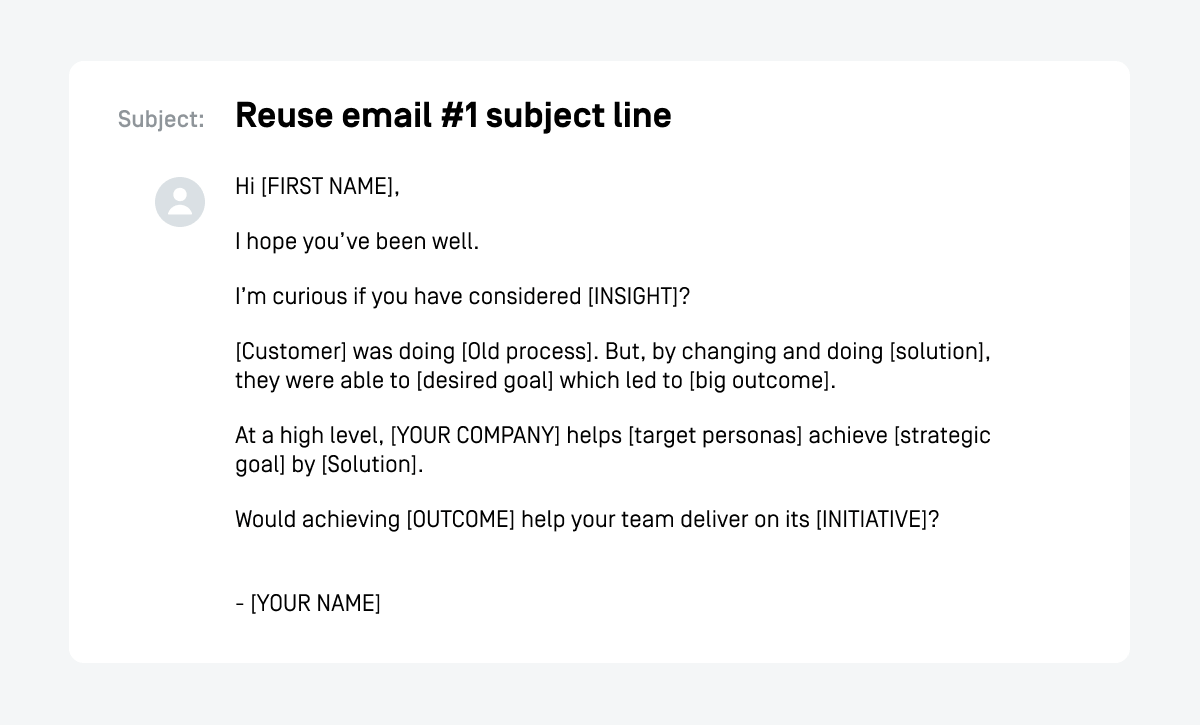Following up on a cold email can be tricky. It’s essential to get it right.
Effective follow-ups increase your chances of a response. Sending a cold email is just the first step. Often, the initial email doesn’t get a reply. This is where a well-crafted follow-up comes in. Knowing how to follow up properly can make all the difference in your outreach efforts.
In this blog post, we’ll explore the best strategies to follow up on a cold email. You’ll learn how to be persistent without being pushy, and how to increase your chances of getting a reply. Let’s dive in and make your follow-up emails work for you.

Credit: liinea.com
Crafting The Perfect Follow-up
Following up on a cold email can feel daunting. But, crafting the perfect follow-up message can make all the difference. Here, we’ll explore how to personalize your message and the best timing for sending your follow-up.
Personalize Your Message
Personalization is key to making your follow-up email stand out. A generic message will likely be ignored. Here are some tips to personalize your follow-up:
- Reference Previous Interaction: Mention your last email or any previous contact.
- Use Their Name: Addressing the recipient by their name adds a personal touch.
- Highlight Their Interests: Show you’ve done your homework. Mention something specific about their work or company.
- Keep It Relevant: Ensure your follow-up message is relevant to their needs and interests.
Here is an example of a personalized follow-up:
Hi [Recipient’s Name],
I hope this email finds you well. I wanted to follow up on my previous email about [specific topic]. I noticed that your company recently [specific event or achievement], which aligns with the solutions we offer.
Looking forward to hearing from you.
Best regards,
[Your Name]
Timing Your Follow-up
Timing is crucial for follow-up emails. Sending them too soon can be seen as pushy. Waiting too long might make the recipient forget about you. Here are some guidelines for timing your follow-up:
- First Follow-Up: Send 3-5 days after the initial email.
- Second Follow-Up: Wait another week if no response.
- Final Follow-Up: Send one last email 2-3 weeks after the second follow-up.
Here is a timeline example:
| Follow-Up Number | Timing |
|---|---|
| First Follow-Up | 3-5 Days After Initial Email |
| Second Follow-Up | 1 Week After First Follow-Up |
| Final Follow-Up | 2-3 Weeks After Second Follow-Up |
By personalizing your message and timing your follow-ups correctly, you increase your chances of getting a response. Stay patient and keep your messages relevant and engaging.

Credit: medium.com
Choosing The Right Subject Line
Choosing the right subject line can make or break your cold email follow-up. It is the first thing your recipient sees. A compelling subject line can increase your open rates. But it needs to be crafted carefully. Here are some tips to help you create the perfect subject line for your follow-up email.
Create Curiosity
Your subject line should create curiosity. It should make the recipient want to open the email. Ask a question or hint at a benefit. For instance, “Quick Question About Your Marketing Strategy.” This makes the recipient curious. They will want to know more.
Keep It Short And Sweet
Avoid long subject lines. They get cut off on mobile devices. Keep it short and sweet. Aim for less than 50 characters. For example, “Follow-Up on Our Last Chat.” This is clear and concise. It gets straight to the point.
Maintaining Professionalism
Following up on a cold email can be tricky. Maintaining professionalism is key. This ensures your email is well-received. It also builds a positive impression of your brand. Let’s explore how to maintain professionalism in your follow-up emails.
Use Proper Language
Always use polite and formal language. Avoid slang or casual phrases. Address the recipient by their title and last name. This shows respect and professionalism.
- Use polite greetings like “Dear Mr. Smith” or “Hello Ms. Jones”.
- End the email with a courteous closing like “Best regards” or “Sincerely”.
Keep your sentences clear and concise. Avoid complex words. This makes your email easy to read. Proofread your email for any errors. Spelling mistakes can harm your professionalism.
Avoid Aggressive Tones
It’s important to keep a calm and respectful tone. Avoid sounding pushy or demanding. This can put off the recipient. Instead, express your interest politely.
| Do | Don’t |
|---|---|
| Use phrases like “I am following up on my previous email”. | Avoid phrases like “Why haven’t you responded yet?” |
| Show appreciation for their time. | Don’t pressure them to respond quickly. |
Here’s a tip: Use a friendly and professional tone. This encourages a positive response.
Adding Value In Your Follow-up
Adding value in your follow-up emails is crucial. It helps build trust and shows you care. Instead of just reminding the recipient, provide something useful. This makes your email stand out and increases the chances of a response. Below are ways to add value in your follow-up emails.
Share Relevant Content
Send articles, blog posts, or reports that might interest them. Choose content related to their industry or challenges. This shows you understand their needs. It also positions you as a helpful resource. Keep the content brief and to the point.
Offer Solutions
Identify their pain points and suggest solutions. Address specific problems they might face. Propose ways your product or service can help. This approach demonstrates your expertise. It shows you have thought about their needs.
Leveraging Social Proof
Following up on a cold email can be challenging. One effective approach is leveraging social proof. Social proof can help build trust and credibility. It shows that others have found value in your message. You can reference testimonials or case studies from satisfied clients to reinforce your points. Additionally, sharing insights on how to write cold emails that have proven successful can further engage your audience. By demonstrating real-world examples of your approach, you not only capture attention but also increase the chances of a positive response. Additionally, sharing testimonials or success stories from previous clients can enhance your message’s impact. When potential recipients see evidence of positive outcomes, they may be more inclined to respond. Understanding how to write effective cold emails is crucial for connecting with your audience and increasing your chances of receiving a reply.
Mention Mutual Connections
One way to leverage social proof is by mentioning mutual connections. This can create an instant connection. People trust recommendations from those they know. Here’s a simple way to include it:
"Hi [Recipient's Name],
I noticed we both know [Mutual Connection's Name]. They spoke highly of your work at [Company Name]."
This makes your email feel more personalized. It also shows you have taken the time to research. Mutual connections can act as a bridge, making it easier for the recipient to trust you.
Include Testimonials
Including testimonials is another powerful way to use social proof. Testimonials from satisfied customers can build trust. They show that others have benefited from your product or service. Here’s an example:
"Hi [Recipient's Name],
Our clients, including [Client Name] and [Client Name], have found great success with our solution. [Client Name] mentioned, 'This service has helped us increase efficiency by 30%.'"
This showcases real results. It provides evidence that your offer is valuable. Make sure the testimonials are relevant. They should resonate with your recipient’s needs and challenges.
| Action | Purpose |
|---|---|
| Mention Mutual Connections | Builds immediate trust and rapport |
| Include Testimonials | Proves the value of your offer |
Using social proof in your follow-up emails can make a significant difference. It builds credibility and shows the recipient that others trust you. This can lead to more positive responses and better engagement.
Using Multiple Channels
Following up on a cold email can be challenging. Using multiple channels can improve your chances of getting a response. Below are some effective methods to follow up.
Follow-up Via Linkedin
LinkedIn is a powerful tool for professional networking. Connect with your cold email recipient on LinkedIn. Send a brief message referencing your email. This adds a personal touch and reminds them of your initial contact.
Here’s a simple LinkedIn message template:
Hi [Recipient's Name],
I sent you an email about [briefly mention your topic].
I wanted to follow up here. Looking forward to connecting.
Best regards,
[Your Name]
Leverage Phone Calls
Phone calls can be highly effective for follow-ups. A quick call can make a significant impact. Keep the call short and to the point. Mention your previous email and express your interest in discussing it further.
Here is a sample script for a follow-up call:
Hi [Recipient's Name],
This is [Your Name]. I emailed you about [topic].
I wanted to follow up and see if we could discuss it further.
Do you have a few minutes to chat?
Thank you!
Using multiple channels for follow-ups increases your visibility and shows your commitment. It helps you stand out in the crowded inbox.
Tracking And Measuring Success
Tracking and measuring success are crucial in the process of following up on cold emails. Without proper tracking, you cannot understand the effectiveness of your email campaigns. This section will delve into the methods of tracking and measuring success.
Use Email Analytics
Email analytics help you gauge the performance of your follow-up emails. Tools like MailChimp and HubSpot provide insights into open rates and click-through rates. High open rates indicate good subject lines. High click-through rates show engaging content. Analyze these metrics to refine your strategy.
Adjust Based On Responses
Responses to your follow-up emails offer valuable feedback. Positive replies mean your message resonates well. No replies or negative feedback suggest room for improvement. Pay attention to the tone and content of responses. Tweak your email copy to better align with your audience’s needs.
Knowing When To Stop
Knowing when to stop following up on a cold email is crucial. Continual emails can annoy recipients and harm your reputation. It’s important to recognize signs of non-interest and respect their time. This ensures you maintain professionalism and avoid being overly persistent.
Recognize Non-interest
Understanding when a recipient is not interested is key. Here are some signs to look out for:
- No response after multiple emails: If you have sent three or more emails and received no reply, it might be a sign of disinterest.
- Explicit rejection: If the recipient clearly states they are not interested, respect their decision.
- Unsubscribes or complaints: Recipients may unsubscribe from your emails or complain. This is a clear indicator to stop.
Respect Recipient’s Time
Respecting the recipient’s time shows professionalism. Here are some ways to do that:
- Limit follow-ups: Avoid sending too many follow-ups. A good rule is no more than three.
- Space out emails: Give enough time between follow-ups, at least a week.
- Offer value: Ensure each email offers something valuable. Do not just repeat your previous messages.
| Follow-Up | Time Gap |
|---|---|
| First Follow-Up | 3-5 days after initial email |
| Second Follow-Up | 7-10 days after first follow-up |
| Final Follow-Up | 10-14 days after second follow-up |

Credit: www.gmass.co
Frequently Asked Questions
How Do I Follow Up On A Cold Email?
To follow up on a cold email, wait a few days, be polite, and remind them of your previous email. Reiterate your value proposition and provide a clear call-to-action.
What Should I Include In A Follow-up Email?
Include a polite reminder of your previous email, your value proposition, and a clear call-to-action. Keep it short and concise.
How Long Should I Wait To Follow Up?
Wait three to five days before following up on a cold email. This allows the recipient enough time to respond.
How Many Times Should I Follow Up?
Follow up two to three times. If you don’t get a response, it may be best to move on.
Conclusion
Following up on a cold email is crucial. Be polite and persistent. Timing matters, so don’t rush. Use a clear and friendly tone. Personalize your message to stand out. Keep it short and relevant. Show value and respect their time.
A well-crafted follow-up can boost your chances. Remember, patience and consistency are key. Practice these tips for better results. Happy emailing!
